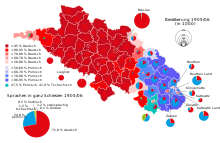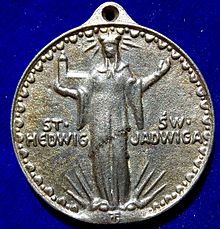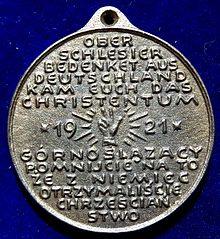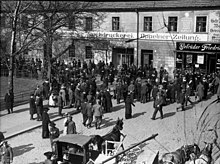
A | B | C | D | E | F | G | H | CH | I | J | K | L | M | N | O | P | Q | R | S | T | U | V | W | X | Y | Z | 0 | 1 | 2 | 3 | 4 | 5 | 6 | 7 | 8 | 9
| Outcome | Upper Silesia is divided. East Upper Silesia goes to Poland. West Upper Silesia goes to Germany. | |||||||||
|---|---|---|---|---|---|---|---|---|---|---|
| Results | ||||||||||
| ||||||||||

Pink = Germany
Green = Poland
Lilac = Czechoslovakia (including, without plebiscite, Hlučín)
Pale green = to Poland following plebiscite
Orange = remaining in Germany following plebiscite
The Upper Silesia plebiscite was a plebiscite mandated by the Versailles Treaty and carried out on 20 March 1921 to determine ownership of the province of Upper Silesia between Weimar Germany and Poland.[1] The region was ethnically mixed with both Germans and Poles; according to prewar statistics, ethnic Poles formed 60 percent of the population.[2] Under the previous rule by the German Empire, Poles claimed they had faced discrimination, making them effectively second class citizens.[3][4][5] The period of the plebiscite campaign and inter-Allied occupation was marked by violence. There were three Polish uprisings, and German volunteer paramilitary units came to the region as well.
The area was policed by French, British, and Italian troops, and overseen by an Inter-Allied Commission. The Allies planned a partition of the region, but a Polish insurgency took control of over half the area. The Germans responded with volunteer paramilitary units from all over Germany, which fought the Polish units. In the end, after renewed Allied military intervention, the final position of the opposing forces became, roughly, the new border. The decision was handed over to the League of Nations, which confirmed this border, and Poland received roughly one third of the plebiscite zone by area, including the greater part of the industrial region.[6]
After the referendum, on 20 October 1921, a conference of ambassadors in Paris decided to divide the region. Consequently, the German-Polish Accord on East Silesia (Geneva Convention), a minority treaty, was concluded on 15 May 1922 which dealt with the constitutional and legal future of Upper Silesia that had partly become Polish territory.
Ethnolinguistic structure before the plebiscite

The earliest exact census figures on ethnolinguistic or national structure (Nationalverschiedenheit) of the Prussian part of Upper Silesia, come from 1819. Polish immigration from Galicia, Congress Poland and Prussian provinces into Upper Silesia during the 19th century was a major factor in their increasing numbers. The last Prussian general census figures available are from 1910 (if not including the 1911 census of school children – Sprachzählung unter den Schulkindern – which revealed a higher percent of Polish-speakers among school children than the 1910 census among the general populace). Figures (Table 1.) show that large demographic changes took place between 1819 and 1910, with the region's total population quadrupling, the percent of Germans increasing significantly, while Polish-speakers maintained their steady increasing numbers. Also the total land area in which Polish was spoken, as well as the land area in which it was spoken, declined between 1790 and 1890.[7] Polish authors before 1918 estimated the number of Poles in Prussian Upper Silesia as slightly higher than according to official German censuses.[8] The three western districts of Falkenberg (Niemodlin), Grottkau (Grodków) and Neisse (Nysa), though part of Regierungsbezirk Oppeln, were not included in the plebiscite area, as they were almost entirely populated by Germans.
| Table 1. Numbers of Polish, German and other inhabitants (Regierungsbezirk Oppeln)[9][10][11] | |||||||||||||||||
|---|---|---|---|---|---|---|---|---|---|---|---|---|---|---|---|---|---|
| Year | 1819 | 1828 | 1831 | 1834 | 1837 | 1840 | 1843 | 1846 | 1852 | 1855 | 1858 | 1861 | 1867 | 1890 | 1900 | 1905 | 1910 |
| Polish | 377,100
(67.2%) |
418,837
(61.1%) |
443,084
(62.0%) |
468,691
(62.6%) |
495,362
(62.1%) |
525,395
(58.6%) |
540,402
(58.1%) |
568,582
(58.1%) |
584,293
(58.6%) |
590,248
(58.7%) |
612,849
(57.3%) |
665,865
(59.1%) |
742,153
(59.8%) |
918,728 (58.2%) | 1,048,230 (56.1%) | 1,158,805 (57.0%) | Census, monolingual Polish: 1,169,340 (53.0%)[12]
or up to 1,560,000 together with bilinguals[8] |
| German | 162,600
(29.0%) |
255,483
(37.3%) |
257,852
(36.1%) |
266,399
(35.6%) |
290,168
(36.3%) |
330,099
(36.8%) |
348,094
(37.4%) |
364,175
(37.2%) |
363,990
(36.5%) |
366,562
(36.5%) |
406,950
(38.1%) |
409,218
(36.3%) |
457,545
(36.8%) |
566,523 (35.9%) | 684,397 (36.6%) | 757,200 (37.2%) | 884,045 (40.0%) |
| Other | 21,503
(3.8%) |
10,904
(1.6%) |
13,254
(1.9%) |
13,120
(1.8%) |
12,679
(1.6%) |
41,570
(4.6%) |
42,292
(4.5%) |
45,736
(4.7%) |
49,445
(4.9%) |
48,270
(4.8%) |
49,037
(4.6%) |
51,187
(4.6%) |
41,611
(3.4%) |
92,480
(5.9%) |
135,519
(7.3%) |
117,651
(5.8%) |
Total population: 2,207,981 |
The plebiscite





The Paris Peace Conference at the end of World War I placed some formerly German territory in neighboring countries, some of which had not existed at the beginning of the war. In the case of the new Polish state, the Treaty of Versailles established some 54,000 square kilometers of formerly German territory as part of newly independent Poland. Many of these areas were ethnically mixed. In three of these ethnically mixed areas on the new German-Polish border, however, the Allied leaders provided for border plebiscites or referendums. The areas would be occupied by Allied forces and governed in some degree by Allied commissions. The most significant of these plebiscites was the one in Upper Silesia, since the region was a principal industrial center. The most important economic asset was the enormous coal-mining industry and its ancillary businesses, but the area yielded iron, zinc, and lead as well. The "Industrial Triangle" on the eastern side of the plebiscite zone – between the cities of Beuthen (Bytom), Kattowitz (Katowice), and Gleiwitz (Gliwice) was the heart of this large industrial complex. The Upper Silesia plebiscite was therefore a plebiscite for self-determination of Upper Silesia required by the Treaty of Versailles. Both Germany and Poland valued this region not only for reasons of national feeling, but for its economic importance as well.
The area was occupied by British, French, and Italian forces, and an Interallied Committee headed by a French general, Henri Le Rond. The plebiscite was set for 20 March 1921. Both Poles and Germans were allowed to organize campaigns. Each side developed secret paramilitary forces – both financed from the opposing capitals, Warsaw and Berlin. The major figure of the campaign was Wojciech Korfanty, a pro-Polish politician.
The Poles carried out two uprisings during the campaign, in August 1919 and August 1920. The Allies restored order in each case, but the Polish insurrectionists clashed with German "volunteers," the Freikorps.[13]
A feature of the plebiscite campaign was the growing prominence of a strong autonomist movement, the most visible branch of which was the Bund der Oberschlesier/Związek Górnoślązaków. This organization attempted to gain promises of autonomy from both states and possible future independence for Upper Silesia.[14]
There were 1,186,758 votes cast in an area inhabited by 2,073,663 people.[15] It resulted in 717,122 votes being cast for Germany and 483,514 for Poland. The towns and most of the villages in the plebiscite territory gave German majorities. However, the districts of Pless (Pszczyna) and Rybnik in the southeast, as well as Tarnowitz (Tarnowskie Góry) in the east and Tost-Gleiwitz (Gliwice) in the interior showed considerable Polish majorities, while in Lublinitz (Lubliniec) and Groß Strehlitz (Strzelce Opolskie) the votes cast on either side were practically equal. All the districts of the industrial zone in a narrower sense – Beuthen (Bytom), Hindenburg (Zabrze), Kattowitz (Katowice), and Königshütte (Chorzów) – had slight German majorities, though in Beuthen and Kattowitz this was due entirely to the town vote (four-fifths in Kattowitz compared to an overall 60%).[16] Many country communes of Upper Silesia had given Polish majorities. Overall, however, the Germans won the vote by a measure of 59.4% to 40.6%.[17] The Interallied Commission deliberated, but the British proposed a more easterly border than the French, which would have given much less of the Industrial Triangle to Poland.


In late April 1921, when pro-Polish forces began to fear that the region would be partitioned according to the British plan, elements on the Polish side announced a popular uprising. Korfanty was the leading figure of the uprising, but he had much support in Upper Silesia as well as support from the Polish government in Warsaw. Korfanty called for a popular armed uprising whose aim was to maximize the territory Poland would receive in the partition. German volunteers rushed to meet this uprising, and fighting on a large scale took place in the late spring and early summer of 1921. Germanophone spokesmen and German officials complained that the French units of the Upper Silesian army of occupation were favoring the insurrection by refusing to put down their violent activities or restore order.
Twelve days after the start of the uprising, Wojciech Korfanty offered to take his Upper Silesian forces behind a line of demarcation, on condition that the released territory would not be occupied by German forces, but by Allied troops. On 1 July 1921 British troops returned to Upper Silesia to help French forces occupy this area. Simultaneously with these events, the Interallied Commission pronounced a general amnesty for the illegal actions committed during the recent violence, with the exception of acts of revenge and cruelty. The German defense force was finally withdrawn.
Because the Allied Supreme Council was unable to come to an agreement on the partition of the Upper Silesian territory on the basis of the confusing plebiscite results, a solution was found by turning the question over to the Council of the League of Nations. Agreements between the Germans and Poles in Upper Silesia and appeals issued by both sides, as well as the dispatch of six battalions of Allied troops and the disbandment of the local guards, contributed markedly to the pacification of the district. On the basis of the reports of a League commission and those of its experts, the Council awarded the greater part of the Upper Silesian industrial district to Poland. Poland obtained almost exactly half of the 1,950,000 inhabitants, viz., 965,000, but not quite a third of the territory, i.e., only 3,214.26 km2 (1,255 mi2) out of 10,950.89 km2 (4,265 mi2) but more than 80% of the heavy industry of the region.[18]
The German and Polish governments, under a League of Nations recommendation, agreed to enforce protections of minority interests that would last for 15 years. Special measures were threatened in case either of the two states should refuse to participate in the drawing up of such regulations, or to accept them subsequently. In the event, the German minority remaining on the Polish side of the border suffered considerable discrimination in the subsequent decades.[19]
The Polish Government, convinced by the economic and political power of the region and by the autonomist movement of the plebiscite campaign, decided to give Upper Silesia considerable autonomy with a Silesian Parliament as a constituency and the Silesian Voivodship Council as the executive body. On the German side the new Prussian province of Upper Silesia (Oberschlesien) with regional government in Oppeln was formed, likewise with special autonomy.
Results

| County | population (1919) | registered voters | turnout | votes for Germany | % | votes for Poland | % |
|---|---|---|---|---|---|---|---|
| Beuthen (Bytom), town [20] | 71,187 | 42,990 | 39,991 | 29,890 | 74.7% | 10,101 | 25.3% |
| Beuthen (Bytom), district [20] | 213,790 | 109,749 | 106,698 | 43,677 | 40.9% | 63,021 | 59.1% |
| Cosel (Koźle), district [21] | 79,973 | 51,364 | 50,100 | 37,651 | 75.2% | 12,449 | 24.8% |
| Gleiwitz (Gliwice), town [22] | 69,028 | 41,949 | 40,587 | 32,029 | 78.9% | 8,558 | 21.1% |
| Groß Strehlitz (Strzelce Opolskie), district [23] | 76,502 | 46,528 | 45,461 | 22,415 | 49.3% | 23,046 | 50.7% |
| Hindenburg (Zabrze), district [24] | 167,632 | 90,793 | 88,480 | 45,219 | 51.1% | 43,261 | 48.9% |
| Kattowitz (Katowice), town [25] | 45,422 | 28,531 | 26,674 | 22,774 | 85.4% | 3,900 | 14.6% |
| Kattowitz (Katowice), district [25] | 227,657 | 122,342 | 119,011 | 52,892 | 44.4% | 66,119 | 55.6% |
| Königshütte (Chorzów), town [26] | 74,811 | 44,052 | 42,628 | 31,864 | 74.7% | 10,764 | 25.3% |
| Kreuzburg (Kluczbork), district [27] | 52,558 | 40,602 | 39,627 | 37,975 | 95.8% | 1,652 | 4.2% |
| Leobschütz (Głubczyce), district [28] | 78,247 | 66,697 | 65,387 | 65,128 | 99.6% | 259 | 0.4% |
| Lublinitz (Lubliniec), district [29] | 55,380 | 29,991 | 29,132 | 15,453 | 53.0% | 13,679 | 47.0% |
| Namslau (Namysłów), district [30] | 5,659 | 5,606 | 5,481 | 5,348 | 97.6% | 133 | 2.4% |
| Neustadt (Prudnik), district [31] | 51,287 | 36,941 | 36,093 | 31,825 | 88.2% | 4,268 | 11.8% |
| Oppeln (Opole), town [32] | 35,483 | 22,930 | 21,914 | 20,816 | 95.0% | 1,098 | 5.0% |
| Oppeln (Opole), district [32] | 123,165 | 82,715 | 80,896 | 56,170 | 69.4% | 24,726 | 30.6% |
| Pleß (Pszczyna), district [33] | 141,828 | 73,923 | 72,053 | 18,675 | 25.9% | 53,378 | 74.1% |
| Ratibor (Racibórz), town [34] | 36,994 | 25,336 | 24,518 | 22,291 | 90.9% | 2,227 | 9.1% |
| Ratibor (Racibórz), district [34] | 78,238 | 45,900 | 44,867 | 26,349 | 58.7% | 18,518 | 41.3% |
| Rosenberg (Olesno), district [35] | 54,962 | 35,976 | 35,007 | 23,857 | 68.1% | 11,150 | 31.9% |
| Rybnik, district [36] | 160,836 | 82,350 | 80,266 | 27,919 | 34.8% | 52,347 | 65.2% |
| Tarnowitz (Tarnowskie Góry), district [37] | 86,563 | 45,561 | 44,591 | 17,078 | 38.3% | 27,513 | 61.7% |
| Tost-Gleiwitz (Gliwice), district [22] | 86,461 | 48,153 | 47,296 | 20,098 | 42.5% | 27,198 | 57.5% |
| Total [38] | 2,073,663 | 1,220,979 | 1,186,758 | 707,393 | 59.6% | 479,365 | 40.4% |
| Total without Namslau district [17] | 2,068,004 | 1,215,373
Zdroj:https://en.wikipedia.org?pojem=Upper_Silesian_plebiscite Text je dostupný za podmienok Creative Commons Attribution/Share-Alike License 3.0 Unported; prípadne za ďalších podmienok. Podrobnejšie informácie nájdete na stránke Podmienky použitia.
Analytika
Antropológia Aplikované vedy Bibliometria Dejiny vedy Encyklopédie Filozofia vedy Forenzné vedy Humanitné vedy Knižničná veda Kryogenika Kryptológia Kulturológia Literárna veda Medzidisciplinárne oblasti Metódy kvantitatívnej analýzy Metavedy Metodika Text je dostupný za podmienok Creative
Commons Attribution/Share-Alike License 3.0 Unported; prípadne za ďalších
podmienok. www.astronomia.sk | www.biologia.sk | www.botanika.sk | www.dejiny.sk | www.economy.sk | www.elektrotechnika.sk | www.estetika.sk | www.farmakologia.sk | www.filozofia.sk | Fyzika | www.futurologia.sk | www.genetika.sk | www.chemia.sk | www.lingvistika.sk | www.politologia.sk | www.psychologia.sk | www.sexuologia.sk | www.sociologia.sk | www.veda.sk I www.zoologia.sk |
